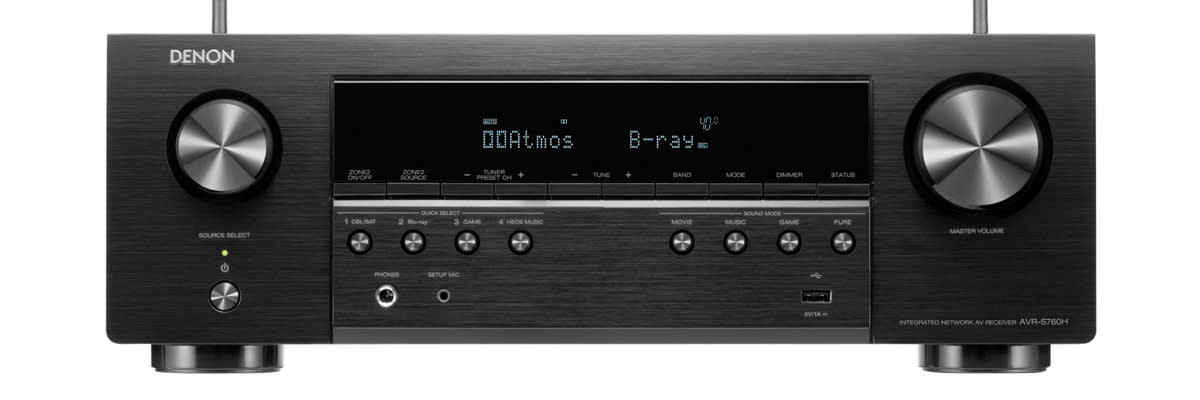
Return navigate_next
What is an Audio Receiver and Do You Need One?
August 23, 2022 *
Besides stunning visuals, the other key part of an amazing home theater experience is crisp, clear audio. That’s what creates a full feeling of immersion and like you’re part of the action. Although not required, one of the electronic components that can make for outstanding sound quality is an audio receiver. Here’s everything you need to know about it.
What is an Audio Receiver?
Simply put, it receives the TV audio signal, processes it, and transmits it to the speakers. An audio receiver’s input can come from a variety of different sources, such as a DVD player, Blu-ray player, video game console, or satellite receiver. From there you can adjust the volume for the optimal sound setting.

What’s the Purpose of an Audio Receiver?
There are two main purposes. One is to amplify the sound that moves from the TV audio signal to the speakers.
The other is to optimize the audio effects to enhance home theater viewing. “An audio receiver has five or more amplifiers to drive five speakers,” explains Home Theater Heroes. “A regular home theater will have five speakers, which together create the surround sound.” That way you can get the most from your audio and have a highly immersive experience watching movies or TV, playing video games, or even listening to the radio.
Do You Need One?
An audio receiver isn’t always required for listening to audio with a home theater. However, if you have traditional speakers, sound experts recommend having an audio receiver. Also, if you have “5.1 or similar surround sound, 7.1 or similar surround sound, or passive soundbars,” it may be required, Home Theater Heroes adds.
Even if you don’t necessarily need a speaker receiver, it can improve overall sound quality. In particular, if you want to enjoy deep bass and feel the full impact of sound effects, an audio receiver is often a good idea.

So if you’re an audio enthusiast and are serious about creating a high-level home theater experience, it’s definitely worth considering.
What’s the Best Audio Receiver?
There are a lot of great products on the market. 2022’s top-ranked speaker receivers based on power, sound, and connectivity are:
- The Denon AVR-X4700H ($2,099) - Although it has a steep price tag, this is an absolute powerhouse with superb bass and is perfect for movies and gaming.
- The Marantz NR1711 ($1,099) - At nearly half the price of the Denon AVR-X4700H, this is a more realistic purchase that’s perfect for those just getting their feet wet with an audio receiver and delivers an amazing “3D listening” experience.
- The Denon AVR-X2700H ($1,099) - This was voted as having the best overall value by Tom’s Guide in 2022 and is ideal for smaller viewing rooms.
Should You Get an Extended Audio Receiver Warranty?
Like most electronic devices, a manufacturer audio receiver warranty typically lasts one year and covers material defects or issues stemming from poor workmanship. During that period, the manufacturer will provide a repair or replacement as long as it meets the conditions stated on their warranty outline. But once that year has ended, you assume responsibility for repairs or replacement moving forward.

Because of the significant investment that goes into most audio receivers and the limited coverage you get with a manufacturer warranty, you should get an extended warranty. Doing so ensures continued protection and provides peace of mind if you run into a major issue.
Note that extended coverage through a provider like Upsie is also far more comprehensive than a basic manufacturer warranty and covers mechanical failure, power failure, sound failure, button failure, and more. Upsie’s TV warranties also protect against dead pixels and screen burn-in.
In addition, Upsie is more affordable than in-store offers. In fact, Upsie plans cost up to 70% less than what you’ll pay for warranties in-store. For example, for a $400 audio receiver, a two-year Upsie warranty costs just $32.99 and a three-year warranty costs $56.99. You can find more info on Upsie plans for audio receivers and compare options here.
Learn More About TVs:
* This article is over 6 months old and may or may not be updated.
